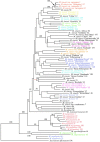Characterization of a genetic resource collection for Miscanthus (Saccharinae, Andropogoneae, Poaceae) using AFLP and ISSR PCR
- PMID: 12099538
- PMCID: PMC4233896
- DOI: 10.1093/aob/mcf091
Characterization of a genetic resource collection for Miscanthus (Saccharinae, Andropogoneae, Poaceae) using AFLP and ISSR PCR
Abstract
Amplified fragment length polymorphism (AFLP) and inter-simple sequence repeat markers were employed to characterize a genetic resource collection of Miscanthus, a grass under trial in Europe as a biomass crop. The 26 polymorphic markers produced by two ISSR fingerprinting primers were able to discriminate taxa and identify putative clones. AFLP fingerprints were fully reproducible and produced a larger number of markers for the three primer pairs tested, of which 998 were polymorphic (representing 79.3% of all bands). AFLP markers distinguished species, infra-specific taxa (varieties and cultivars) and putatively clonal material. They were also used to assess the inter-relationships of the taxa, to investigate the origin of important hybrid plants and to estimate the overall level of genetic variation in the collection. They were useful for assessing the species status of certain taxa such as M. transmorrisonensis, an endemic from Taiwan that was clearly distinct from M. sinensis; whereas other taxa of disputed species status, such as M. condensatus and M. yakushimanum were not genetically distinct from M. sinensis. The AFLP markers detected a high degree of infra-specific variation and allowed subdivisions of the genetic resource collection to be made, particularly within M. sinensis.
Figures




References
-
- AdatiS, Shiotani I.1962. The cytotaxonomy of the genus Miscanthus and its phylogenic status. The Bulletin of the Faculty of Agriculture, Mie University 25: 1–14.
-
- BaumBR, Appels R.1992. Evolutionary change at the 5S DNA loci of species in the Triticeae. Plant Systematics and Evolution 183: 195–208.
-
- BullardMJ, Heath MC, Nixon PM.1995. Shoot growth, radiation interception and dry matter production and partitioning during the establishment phase of Miscanthus sinensis ‘Giganteus’ grown at two densities in the UK. Annals of Applied Biology 126: 94–102.
-
- BullardMJ, Nixon PM, Heath MC.1997. Quantifying the yield of Miscanthus × giganteus in the UK. Aspects of Applied Biology 49: 199–206.
-
- CasgrainP.1999. Le Progiciel Rv4·0d1. Development Release.
Publication types
MeSH terms
Substances
LinkOut - more resources
Full Text Sources
Molecular Biology Databases

